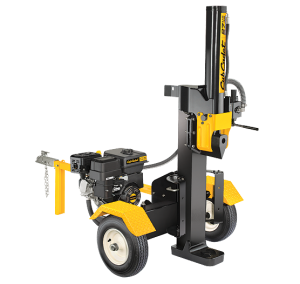 The Cub Cadet LS 25 can provide years of reliable service, but only if it is maintained correctly. This guide will help you keep your log splitter working through the year and keep it safe during the off-season.
The Cub Cadet LS 25 can provide years of reliable service, but only if it is maintained correctly. This guide will help you keep your log splitter working through the year and keep it safe during the off-season.
Engine
Refer to the engine operator’s manual, included with this log splitter, on how to maintain your device’s engine.
Tire Pressure
The tires should be inflated to 30 psi (2.1 Bar.) Do not exceed this pressure: doing so may cause the tire to forcefully unseat itself from the wheel, causing serious injury.
Hose Clamps
Check the clamps on the return hose, connected to the cylinder, before each use. Check the clamps on the suction hose, located below the engine and reservoir tank, once per season.
Hydraulic Filter
The filter should be changed every 50 hours of operation. A 10-micron filter is required for this equipment.
Hydraulic Fluid
Check the fluid level of the reservoir tanks before each use, adding fluid as needed to keep the level within the marks on the dipstick. The fluid in the tank should be replaced every 100 hours of operation, and the filter should be replaced at the same time, regardless of age.
Approved fluids for use in this log splitter include Shell Tellus 52 M 32, Dexron III/Mercon automatic transmission fluid, Pro-Select AW-32 hydraulic oil and Pro-Select 10WAW-ISO Grade 32 hydraulic oil. These fluids should not be mixed.
1. Place an adequately-sized oil collection container beneath the tank. The tank holds three gallons of hydraulic fluid, while the entire system holds 4.7 gallons.
2. Disconnect the suction hose from the bottom of the tank.
3. Unscrew the inlet filter from inside the tank opening and clean it with a penetrating oil.
4. Allow the fluid to drain into the container.
5. Reinstall the filter screen and suction hose. Tighten the hose clamp.
6. Add fluid and check the dipstick, being careful not to overfill.
7. Screw the dipstick/cap into the tank.
8. Disconnect the spark plug cap from the plug. Prime the pump by pulling the recoil starter as far as it will go at least 10 times.
9. Reconnect the spark plug cap and start the engine.
10. Use the control handle to move the wedge to its farthest extended position, then back to its start position.
11. Check the fluid level in the tank and add additional fluid as needed.
12. Fully extend and retract the wedge 12 times to bleed the system. It’s normal for fluid overflow to seep from the vent plug.
Beam and Splitting Wedge
Using engine oil, lubricate the top, sides and bottom of the beam as well as the area that contacts the wedge.
Off-Season Storage
Follow these steps if the splitter won’t be used for more than 30 days:
1. Read the storage recommendations for the engine as listed in the engine manual.
2. Thoroughly clean the log splitter. Pressure washers and hoses should not be used as these can wash away lubrication around engine bearings, reducing the motor’s life.
3. Wipe the machine with an oiled rag to prevent rust. Pay particular attention to the wedge and beam.
4. Store the splitter in a clean, dry area away from corrosive materials including fertilizer and acids. If the storage area isn’t vented, add a coating of light oil or silicone to the unit to prevent rust.
Where to Buy Cub Cadet Log Splitter Parts
Cubparts.com carries OEM parts for everything Cub Cadet from their first tractors to the latest in small engine equipment. Whether you need a hose clamp, a hydraulic filter or something much bigger, they can ship to you anywhere in the U.S. and Canada.
Now that winter is winding down, what are you doing to get your equipment ready for the next season?
